ASUS P5NSLI: Core 2 Duo and SLI on a Budget
by Gary Key on August 22, 2006 5:30 AM EST- Posted in
- Motherboards
ASUS P5NSLI: Features
ASUS designed an extremely well laid out board with all major connections easily reached. The ASUS layout provides very good clearance for cards and components while being simple to install in a mid-size ATX case. The board features a 3-phase voltage regulator power design that provided very good stability during general usage and overclocking.
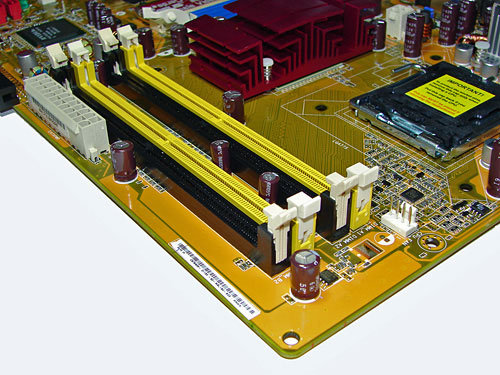
The DIMM module slots' color coordination is correct for dual channel setup. The memory modules are slightly difficult to install with a full size video card placed in the first PCI Express X16 slot. The 24-pin ATX connector is conveniently located on the edge of the board in front of the number four DIMM slot. The CPU fan header is located at the edge of the number one DIMM slot and due to the distance from the CPU it requires your heatsink/fan to be properly oriented if the cable is short.
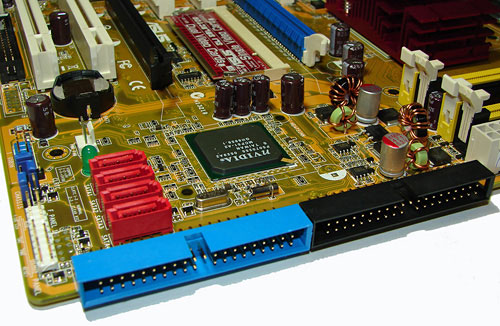
The red NVIDIA 570SLI SATA ports are conveniently located on the board's edge and in front of the blue IDE port connector. Unlike other recently reviewed boards the SATA ports are not color coded for primary and secondary operation, though that is a minor concern. We found the positioning of the SATA ports to be excellent when utilizing the PCI slots, primary IDE port connector, or the second X16 PCI Express slot. The NVIDIA MCP51 chipset does not require a heatsink for cooling.
The blue primary and black secondary NVIDIA 570SLI IDE port connectors are located on the edge of the board and did not present any connection issues in our mid-size ATX case. The location of this connector is very good for most cases and those users still utilizing IDE hard drives. The chassis panel, CMOS jumper block, and fan header is located on the left edge of the board. The clear CMOS jumper block is a traditional jumper design and is easily accessed.
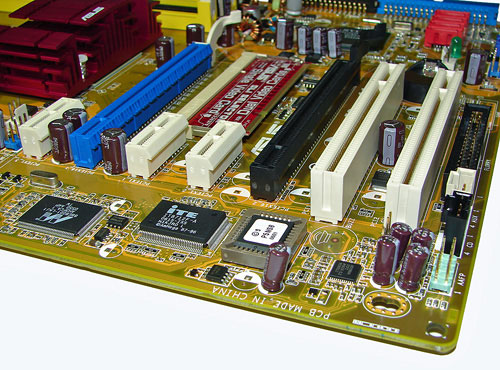
The board comes with two physical PCI Express X16 connectors, three PCI Express X1 connectors, and two PCI 2.3 compliant 32-bit connectors. The layout of this design offers an exceptional balance of expansion slots for a mainstream board.
The first PCI Express X1 connector is located to the right of the second chassis fan header, above the primary X16 slot. The location of this PCI Express X1 connector allows installation of most peripheral PCI Express cards and is not blocked by most video card designs.
The first physical X16 connector (blue) is located next and is followed by the second and third PCI Express X1 connectors. When utilizing a dual slot video card the second PCI Express X1 connector will be physically rendered useless. We did not have any issues utilizing this slot with video cards containing single slot cooling systems.
The second physical X16 connector (black) is located next and is followed by the two PCI 2.3 compliant 32-bit connectors. When utilizing a dual slot video card the first PCI connector will be physically rendered useless. Again, we did not have any issues using this slot with cards containing single slot cooling systems.
The SLI paddle card is located behind the two PCI Express X1 slots and must be installed properly for SLI or multiple GPU installations. The black floppy drive connector is located in an inconvenient position next to the last PCI slot.
Returning to the CPU socket area, we find an ample amount of room for alternative cooling solutions. We utilized the stock Intel heat sink but also verified several aftermarket cooling systems such as the Thermaltake Big Typhoon, Zalman CNPS 9500, Tuniq 120 Tower, and our Scythe Infinity would fit in this area during our tests. However, due to the SPP heatsink size the installation of larger air or water-cooling solutions could be problematic.
The NVIDIA nForce 570SLI SPP chipset is passively cooled with a large heatsink unit that did not interfere with any installed peripherals. Our only concern is the heat generated by the SPP causes the heatsink to reach temperatures that can burn your fingers after extended use. While the system remained very stable we would highly suggest a cooling solution for this area.
ASUS places the four-pin ATX power connector at the top of the CPU socket area and near the SPP heatsink. This connector is located in a difficult position and can hamper airflow with cabling that crosses over directly over the CPU heatsink/fan. During our testing with the Zalman CNPS 9500 we had to bend our 4-pin connector and run the cable around the heatsink fins in order to connect it. This is our lone issue with the general layout and usage of peripherals on this board.
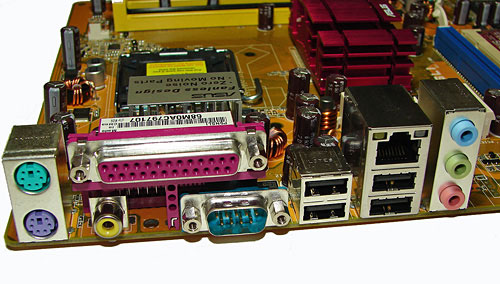
The PS/2 mouse and keyboard ports are located to the far left of the I/O panel. The serial port (COM1) is located to the left of the USB ports and below the LPT parallel port. The S/PDIF coaxial out connector is located to the right of PS2 ports. The LAN (RJ-45) port and the second pair of USB 2.0 connectors are located next to the first set of USB ports. The LAN (RJ-45) port has two LED indicators representing Activity and Speed of the connection. The audio panel consists of three ports that can be configured for 2, 4, and 6-channel audio connections.
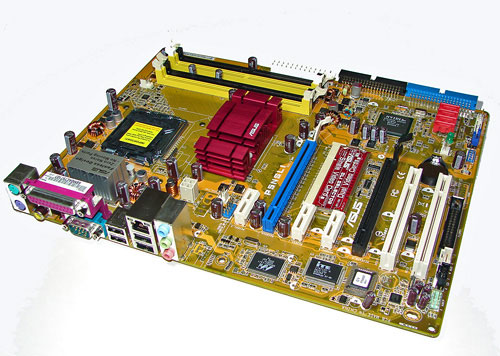 |
| Click to enlarge |
ASUS designed an extremely well laid out board with all major connections easily reached. The ASUS layout provides very good clearance for cards and components while being simple to install in a mid-size ATX case. The board features a 3-phase voltage regulator power design that provided very good stability during general usage and overclocking.

The DIMM module slots' color coordination is correct for dual channel setup. The memory modules are slightly difficult to install with a full size video card placed in the first PCI Express X16 slot. The 24-pin ATX connector is conveniently located on the edge of the board in front of the number four DIMM slot. The CPU fan header is located at the edge of the number one DIMM slot and due to the distance from the CPU it requires your heatsink/fan to be properly oriented if the cable is short.

The red NVIDIA 570SLI SATA ports are conveniently located on the board's edge and in front of the blue IDE port connector. Unlike other recently reviewed boards the SATA ports are not color coded for primary and secondary operation, though that is a minor concern. We found the positioning of the SATA ports to be excellent when utilizing the PCI slots, primary IDE port connector, or the second X16 PCI Express slot. The NVIDIA MCP51 chipset does not require a heatsink for cooling.
The blue primary and black secondary NVIDIA 570SLI IDE port connectors are located on the edge of the board and did not present any connection issues in our mid-size ATX case. The location of this connector is very good for most cases and those users still utilizing IDE hard drives. The chassis panel, CMOS jumper block, and fan header is located on the left edge of the board. The clear CMOS jumper block is a traditional jumper design and is easily accessed.

The board comes with two physical PCI Express X16 connectors, three PCI Express X1 connectors, and two PCI 2.3 compliant 32-bit connectors. The layout of this design offers an exceptional balance of expansion slots for a mainstream board.
The first PCI Express X1 connector is located to the right of the second chassis fan header, above the primary X16 slot. The location of this PCI Express X1 connector allows installation of most peripheral PCI Express cards and is not blocked by most video card designs.
The first physical X16 connector (blue) is located next and is followed by the second and third PCI Express X1 connectors. When utilizing a dual slot video card the second PCI Express X1 connector will be physically rendered useless. We did not have any issues utilizing this slot with video cards containing single slot cooling systems.
The second physical X16 connector (black) is located next and is followed by the two PCI 2.3 compliant 32-bit connectors. When utilizing a dual slot video card the first PCI connector will be physically rendered useless. Again, we did not have any issues using this slot with cards containing single slot cooling systems.
The SLI paddle card is located behind the two PCI Express X1 slots and must be installed properly for SLI or multiple GPU installations. The black floppy drive connector is located in an inconvenient position next to the last PCI slot.
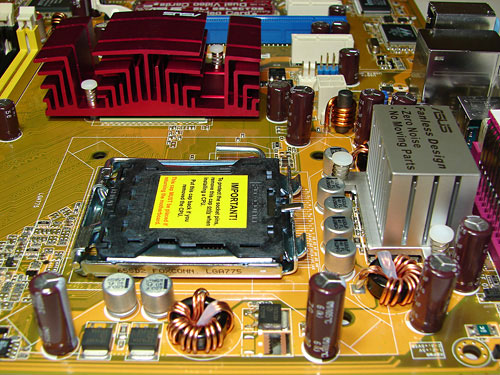 |
| Click to enlarge |
Returning to the CPU socket area, we find an ample amount of room for alternative cooling solutions. We utilized the stock Intel heat sink but also verified several aftermarket cooling systems such as the Thermaltake Big Typhoon, Zalman CNPS 9500, Tuniq 120 Tower, and our Scythe Infinity would fit in this area during our tests. However, due to the SPP heatsink size the installation of larger air or water-cooling solutions could be problematic.
The NVIDIA nForce 570SLI SPP chipset is passively cooled with a large heatsink unit that did not interfere with any installed peripherals. Our only concern is the heat generated by the SPP causes the heatsink to reach temperatures that can burn your fingers after extended use. While the system remained very stable we would highly suggest a cooling solution for this area.
ASUS places the four-pin ATX power connector at the top of the CPU socket area and near the SPP heatsink. This connector is located in a difficult position and can hamper airflow with cabling that crosses over directly over the CPU heatsink/fan. During our testing with the Zalman CNPS 9500 we had to bend our 4-pin connector and run the cable around the heatsink fins in order to connect it. This is our lone issue with the general layout and usage of peripherals on this board.

The PS/2 mouse and keyboard ports are located to the far left of the I/O panel. The serial port (COM1) is located to the left of the USB ports and below the LPT parallel port. The S/PDIF coaxial out connector is located to the right of PS2 ports. The LAN (RJ-45) port and the second pair of USB 2.0 connectors are located next to the first set of USB ports. The LAN (RJ-45) port has two LED indicators representing Activity and Speed of the connection. The audio panel consists of three ports that can be configured for 2, 4, and 6-channel audio connections.










27 Comments
View All Comments
Gary Key - Tuesday, August 22, 2006 - link
That is due to the fact they are using a different chipset than the AM2 family although the marketing language is the same.
scott967 - Tuesday, August 22, 2006 - link
I'm trying to understand the chart on memory which compares different chipsets. The Via PT580 falls apart on Sandra standard going from 533 to 667 memory. Is this correct?scott s.
.
Gary Key - Tuesday, August 22, 2006 - link
That is correct. ASRock and VIA have figured out the issue, just waiting on a fix that hopefully is bios related and nothing else.
Spacecomber - Tuesday, August 22, 2006 - link
This came up before with another article, but perhaps it needs to be said again, I wish that Anandtech would stop using charts showing comparitive FPS that don't show a full FPS axis that starts with zero.I understand that you are trying to highlight the small differences that are being measured and that if you have a chart that uses a proper axis, starting at zero, these differenes are harder to see. However a chart with an axis starting with zero is still a better representation of the results than using a distorted graph to draw out the differences.
Essentially, all you have graphed are the differences between the different results, and if this is what you want to do that is fine. Just relabel the graph and change the axis to show this. Call it something like "Increase in FPS with Memory Speeds Faster than DDR2-663" and then have an axis that runs from 0 to 5 FPS, since that should about cover all your results.
Obviously, such a graph would not be very appealing or interesting, but it would be in better keeping with your data. And, the fact that it doesn't seem to be a very informative graph is precisely my point. Trying to dress these charts up, which really are only charts of the small differences between your results, as if they also provide a relative comparison of the different FPS with different motherboards and different memory timings, simply confounds things. You would do better to pick one or the other to represent, but not mash both together as you are doing now.
It is bad enough that these statistics are posted in such a manner that pays little heed to the kinds of variations that are involved. Magnifying tiny differences in order to make them seen more significant only compounds the problem. Without these distorted graphs a reader might more correctly conclude that the differences in the frame rates, comparing these two different motherboards while using memory running at different speeds, are essentially insignificant. And, drawing out speculative conclusions, based on the perception of any differences, is most likely just much ado about nothing.
hibachirat - Wednesday, August 23, 2006 - link
I don't mind those. But the red and green lines are to close for my red-green color blindness. I can almost tell them apart...but would be nice it the green was brightened and/or the red darkened just a bit.Gary Key - Tuesday, August 22, 2006 - link
Zero based graphs are available by clicking on the orginal image. :)Gary Key - Tuesday, August 22, 2006 - link
Our full review will not utilize these charts. Instead of separating the information and showing pages and pages of the data we felt like this was the best way to collectively show it all at once. We end up with either a graph that has the majority of data points stacked into a single line path or the other evil of not having a zero based graph. We are still working on an updated engine so hopefully this issue disappears quickly or we go back to the bar charts.
Personally, it really bothers me not to have a zero base graph. I will work on another alternative today and update the article if it works. Thanks for the comments and we do agree with you.
JarredWalton - Tuesday, August 22, 2006 - link
We have added a zero-based graphs as pop-ups if you want to see those results. The number tables at the bottom of the charts are intended to help you see that the scores really aren't that far apart, but now you can see the true relative difference.shecknoscopy - Tuesday, August 22, 2006 - link
Well, I've never been that discouraged with their axis labeling, but I could see how someone unfamiliar with the world of statistics could be misled by purported performance differences that are actually within the measurement error.Personally, if I were the one reporting these data, I'd use <b>both</b> methods. Plot the data as you currently do - so as to highlight subtle differences, and <b>also</b> place them on a full graph (where y ranges between 0 and the maximum observed value) in an inset. That way you get a nice zoom-in on the "interesting stuff," and a smaller zoom-out to illustrate that the differences are typically minor, compared to the absolute values.
I'll also point out that, if you <i>really</i> want to get persnippity about their stats reporting, you should demand that they repeat their tests several times, and report each datum with an error bar. :)
Of course, most of my suggestions for improvement involve the word "bar."
-sheq
Renoir - Tuesday, August 22, 2006 - link
I feel it's important to put a lot of these results in perspective with regards to their level of significance. For me personally when looking at results I find the thing that I find most useful is percentages. Lately it seems that a lot of system variables (memory timings/frequency, cpu cache etc) often result in differences of less than 10% in most cases which to me isn't that significant when just getting 1 higher speed bin on your cpu would get you that and probably for less money than say buying the very best ram. I guess I'm saying that when I see graphs that are zoomed in to highlight minor differences I find myself thinking "ok I see why they've done that but it would be nice to be given a percentage so that I can make a quick and dirty evaluation of whether the difference is significant or not". Just some random thoughts :-)